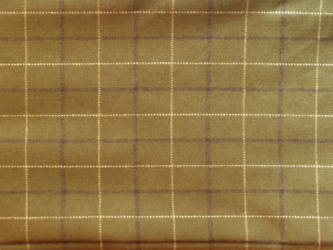

Tartan is a woven fabric, traditionally linked to Scotland. It has become almost a "badge" of "Scottishness".
Traditionally, tartans (or check patterns) were woven using local plant materials for dyes (availability of certain plants locally determining which colours would be abundant). Tartans were useful for camouflage amongst hill and heath, therefore it was common for drab hues to be used in the dying process, i.e. browns, blues and purples (which would differ greatly from what we now associate with tartans with vivid, bright, gaudy colours).
Colours of the dyes used and also the weave patterns, i.e. large checks of the Lochaber region or the closer-knit of checks woven in Caithness could have represented the geographical origin of the wearer, rather than which clan he belonged to.
The "great kilt" (or philamhor) was, as the name suggests, a wide, long swathe of cloth, folded and belted around the body. It was essentially a hill-man's garb on account of the fact that in the hills you would be wading through burns and wet grass, etc. Breeks or trousers would be useless in such conditions as constant wet legs would be incredibly uncomfortable. The "great kilt" was a blanket as well as clothing so therefore was useful on long cattle-droving expeditions, or indeed, warring (which was common). The fact that it was combined clothing and bedding eliminated the need to carry luggage, so enabling the wearer to travel light. In actual fact, the widespread wearing of the kilt was not in existence until the 1600s (most common people would wear leather or skins or indeed whatever they could find to wear on account of the fact that wool was not widespreadly available to common people, as is traditionally thought).
After the Jacobite rebellion of 1745, the British government decided once and for all to eradicate the threat imposed (as they saw it) by the barbaric highlanders. The wearing of tartan, i.e. plaids, kilts, and all other emblems of "highlandness" were proscribed (presumably they thought that tartan was a badge of the highlanders' identity and therefore was seen as an instrument of war? ... as were the bagpipes and all other so-called emblems of Scottishness, including the language). These laws were imposed under pain of death or transportation. The proscription law was repealled in 1782, but by that time the use of the kilt had dwindled. It was used for military purposes during this time, when "government" tartans appeared. These "government" tartans, i.e. Black Watch, were probably among the first representative tartans. Chiefs of clans, however, may indeed have commissioned "specialist" tartans as their private property. These "specialist" tartans were a visibly recognisable trademark to the specific owner of the weave. Clan differentiation existed in the form of "plant badges", specific plants being recognised as regional indicators of provenance, i.e. oak leaves for Stewarts, myrtle for Campbells and Hazel for Colqhouns. So plants played a vital role in identification, from dyes to badges.
In 1822 George IV planned a visit to Edinburgh. In Edinburgh at this time, Sir Walter Scott was a prominent member of society. Scott and other social dignitaries planned a welcoming committee for the royal visit and it was decided that the Scottish capital would lay on a SCOTTISH reception. The weaving industry soon found itself innundated with orders to weave tartan, so all the socialites could be ever so "Scottish". At this time, "specialist" tartans were being designed. Those of Scottish name traditionally associated with specific tartan, commissioned its weaving by the mile length. Those of non-Scottish names commissioned tartans also. This is the point where the most gaudy, loud, contrived tartans were born. The kilt also underwent renaissance at this period, its width being halved, thus giving birth to the short kilt (or philabeg) which we now see at weddings, royal visits and ceremonial "estate pheasant murder".
With Scottishness becoming fashionable all over the capital, soon the unkempt wildernesses of the remoter parts of Scotland became the vogue also, attracting visitors by the thousand. The introduction of railways and the building of the royal retreat of Balmoral increased the fashionability to alarming proportions. Fashionable Scottish bandwagoning was rampant amongst society people and townsfolk, writers and artists embellishing old Scottish tales and inventing new ones and more or less "romanticising" a culture which, not too many years before, they had loathed and feared and viewed as the poor relations. Romantic images of tartan-clad denizens of Scottishness were introduced into the public imagination and still exist today, i.e. shortbread tin imagery and tartan coats for wee doggies ... they've even put ice in our whisky!!!
Thanks to the romantic era there have been several Scottish myths born. Before the romantic era the highlands were a feared place, held in awe on account of their rugged, wild, unkempt countenance. The Highlands and highland culture were seen by lowland people and town-dwellers as barbaric, wild, savage, remote, unspeakable places populated by savages. The idea of scenic beauty before this time was the subdued, tamed, sculptured, ordered, ornamental gardens and parks - the image of kilted savages was abhorrent to these people and highlanders were almost demonised in the public psyche.
So, as we can see, the idea of "clan tartans" was a product of the "romanticisation" of Scotland during the romantic era. As a result of this, a distorted view of Scots and Scottishness has arisen, the Scottish caricature image promoted and perpetuated by the likes of Sir Walter Scott and Sir Harry Lauder (most eminent ambassadors for Scotland, as they were). In modern-day popular imagination, the image of a Scot has become linked to the wearing of gaudy, coloured short kilts and black barathea jackets with shiny buttons, as worn at weddings and functions etc, quite remote from its origins.
******************